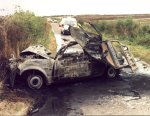| THUMBNAIL
| DESCRIPTION
|

| An insecure steel pipe has burst through the trailer headboard and through the cab during heavy braking. Note that the rear wheels of the tractor unit are off the ground.
|

| In what order did these vehicles arrive at the scene? Marks on the road and damage patterns decide the answer.
|

| A typical pedestrian collision. The damage pattern is parallel with the longitudinal axis of the car showing that the pedestrian was either stationary or moving very slowly across the road. The damage indicates a collision at more than 35 miles per hour.
|

| Hitting a tree is really devastating. In this accident the car hit the tree backwards. The car then rotated around the tree and split in half with the front end going around the tree in one direction and the rear end going around the tree in the opposite direction. The front end and the rear end met each other. The two halves of the car were still attached by some bodywork which was wrapped extremely tightly around the tree.
|

| This car hit three elderly pedestrians at high speed. The occupants ran off leaving the pedestrians lying in the road.
|

| The driver of this car survived with no broken bones and no really serious injuries !
|

| This car came around a blind bend and crashed into an on coming lorry. The car burst into flames. Tyre and scrape marks enabled the speed of the car and the actions of the driver to be assessed. The lorry's tachograph chart provided evidence of its speed and the manner in which it was being driven.
|

| This is what happens when you crash into the back of another lorry. Was the driver paying attention to the road ahead? Did the other driver pull out suddenly into the path of this lorry? The tachograph charts reveal all.
|

| In a collision between a car and a pedestrian, there is frequently a head impact with the windscreen or some other part of the car or with the road. Any kind of head impact can cause any degree of brain injury severity. Note the lack of external evidence of a serious head injury in this picture. See the extent of the fatal injury in the picture below.
|

| After folding back the scalp and removing the top of the skull, this shows the fatal injury sustained by the brain. Blood has flowed into the space between the brain and the skull to form a haematoma. The resultant pressure on the brain has been fatal.
|

| Locked wheel tyre marks and tyre scuff marks enabled the speed of both vehicles to be calculated. The actions of both drivers could also be determined. An independent estimate of speed can also be made from the damage sustained by each vehicle.
|

| Photographs taken on film are usually reliable. Digital pictures can easily be falsified. Compare this picture with the original photograph shown above. How many differences can you spot? Click on the thumbnail picture to see both images side by side.
|

| These vehicles were side-swiped by an HGV Trailer. The caravan has been completely destroyed.
|

| This Taxi came down the wrong sliproad onto a motorway. It collided head-on with motorway traffic.
|

| The blue car became air-borne on a hump-backed bridge and crashed head-on into the white car. How did the white car get behind the blue car?
|

| The Toyota Pickup was towing a horse box towards a cross-roads junction. The driver wished to cross the main road and enter a minor road on the other side of the junction. A motor cycle was coming along the main road but was not yet visible to the pickup driver. As the pickup driver carried out his manoeuvre, the motorcyclist came into view and braked heavily. The motorcycle fell to the ground. The motorcycle and motorcyclist went between the pickup and the horsebox. The motorcyclist hit the drawbar and was cut in half. Notice how the scrape marks on the road surface lead to the horsebox indicating that the pickup was moving forwards when the collision occurred.
|

| This is an example of a striated tyre mark caused by a car travelling around a bend at 60 miles per hour. The striations are produced by rapid relaxations of the distorted tyre as it tries to maintain its frictional grip on the road surface.
|

| This is a video clip taken from a helicopter showing the effect of a sideswipe accident. The clip was obtained by Jeff Udall in Ontario.
Note: Clicking on the thumbnail will download the video to your Downloads folder. Play the video directly from there if this happens.
|

| This is a video clip showing a predominantly elastic collision. Note the lack of damage to the rear of the car and that the car's delta-V is greater than the car's impact speed of 4.6 mph.
Note: Clicking on the thumbnail will download the video to your Downloads folder. Play the video directly from there if this happens.
|


















